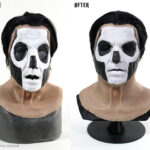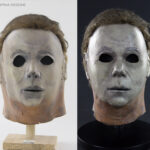Restoration vs conservation – What’s best for your prop?
To RESTORE or CONSERVE, that is the question!
We often get collectors, auction houses or curators looking to preserve their valuable movie props and costumes. The two main avenues for this are conservation and restoration. This article is a brief overview highlighting the difference between restoration and conservation and gives a bit of insight into our approach to each.
CONSERVATION
Conservation is more about preventative measures rather and repair… doing what we can to pause the hands of time. With restoration, the goal is to turn back the hands of time, although to what degree will depend on the materials, the nature of the piece and the personal preferences of the owner or curator of the colleciton.
With conservation we focus on keeping the piece in its current condition and helping it to stay that way as long as possible over time. The primary actions here are things like creating a custom archival supports to keep gravity at bay. Also important could be making internal repairs or reinforcements that won’t be visible when viewing the piece normally. Often there will be areas that gravity may want to pull on (the bridge of the nose on a latex mask) and reinforcing that internally can be a huge help to the piece over time. Further, there are times where a prop has a small crack, which, if left without reinforcement or repair, can leave the piece vulnerable to larger damage in the future. Also, there are times (as in the case of foam materials), where sealing and reinforcing specific materials to add additional stability.
A perfect example of this sort of work is our conservation of a Sam mask from the movie Trick ‘r Treat. The mask came to our studio in great shape, but in order to maintain that condition we created a custom archival insert to support the front-heavy mask and bib. This is a challenge we’ll often run into. Some pieces have heavy internal skulls and mechanics and fragile foam skins. Supporting both the mechs and the foam can dramatically help the piece age more gracefully. Additionally, we gave this entire mask several generous coatings specialized sealers to help bind the paint and protect the foam over time.
RESTORATION
Proper restoration always begins with conservation. We take the same steps above to prepare and support the piece for the long-term as best we can before we look at adding new material to fill in the gaps. With both approaches, you have the benefits of proper support and improved display, which can also add longevity and enjoyability to a prop. Restoration is the next step after conservation, where you move to improving the look for a better display.
It is often for the props or costumes to which time has been less kind. Foam latex (which is used on many movie prop creatures and special effects makeup prosthetics) and slip latex (like the kind used in old-school rubber masks) are some of the most common materials that we see. They’re amazingly flexible materials during their use in productions, but, over time they become quite rigid and fragile.
They are especially prone to cracking and those are the sorts of cracks that can worsen dramatically without treatment. In an ideal world, we’d love to keep every prop with 100% original material, but there are some cases where the props that come to us are so at-risk, that without more dramatic restoration work, they might be lost entirely.
You can see the types of issues foam latex can exhibit in our restoration of the Jack puppet from An American Werewolf in London. Over the years the foam had become fragile and brittle, and many of those pieces became loose from the rest of the puppet. By patching the missing areas of foam latex, we were able to provide stability and save many of the remaining areas of original material.
Even during restoration, we still try to maintain as much original material as possible, and not cover up original paint or finish unnecessarily. It is why we employ techniques like “in-painting.” When our artists are restoring a piece they will only paint areas that they have patched or where new material has been added, painstakingly matching the surrounding original paint. It is a much more tedious and time consuming process than repainting the whole item (the way a car “restoration” is often done), but it means that we are able to visibly maintain as much original material as possible and preserve potential screen matching in the future.
We are all huge movie fans here and maintaining the history behind these pieces is very important to us on a personal level. Whether we restore or conserve a piece, our main concern is always safely maintaining the history of the piece.
With each individual prop or costume we examine all of the different factors regarding the safety and longevity of the piece as well as our client’s preferences and come up with a unique approach that is the best fit for that specific project.
Do you have questions about specialized care, restoration or conservation for your own prop or costume? Email or call today and let’s discuss your project!











